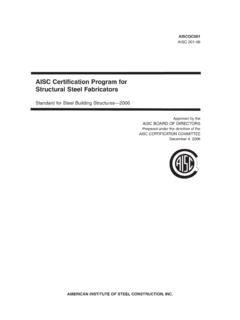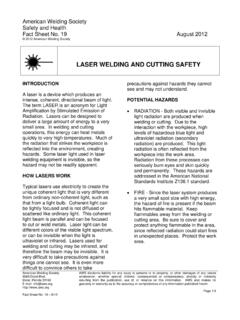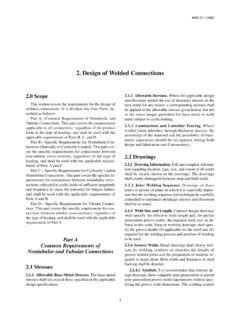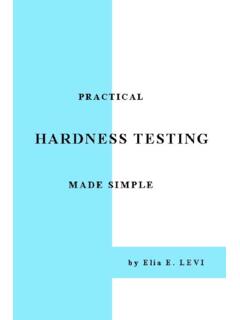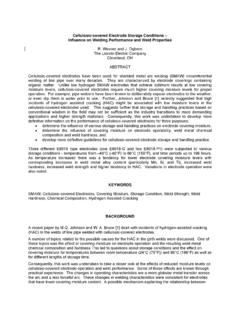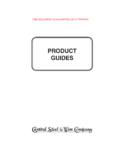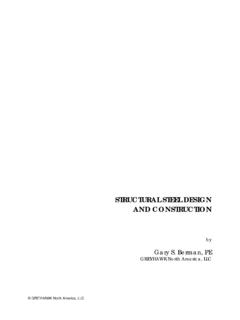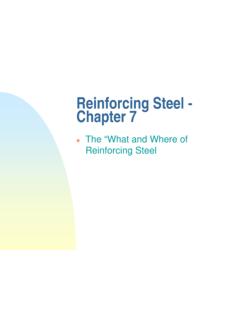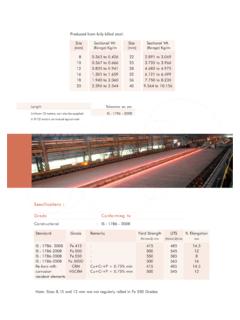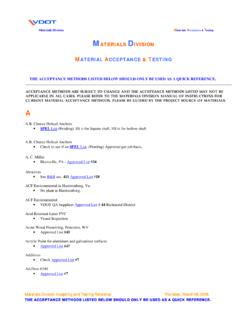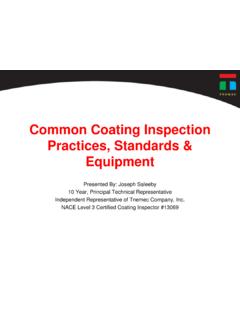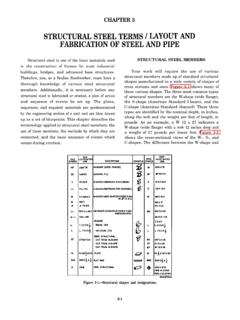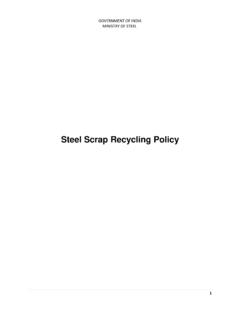Transcription of Structural Steel Welding
1 An Approved Continuing Education Provider PDH Course S150 Structural Steel Welding Semih Genculu, 2007 PDH Center 2410 Dakota Lakes Drive Herndon, VA 20171-2995 Phone: 703-478-6833 Fax: 703-481-9535 PDH Course S150 Semih Genculu Page 2 of 18 Structural Steel Welding Semih Genculu, Arc Welding requires striking a low-voltage, high-current arc between an electrode and the workpiece (base metal).
2 The intense heat generated with this arc melts the base metal and allows the joining of two components. The characteristic of the metal that is being welded and the joint type ( groove, fillet, etc.) dictates the Welding parameters and the procedure that needs to be followed to obtain a sound weld joint. Typical Arc Welding Processes: Shielded metal arc Welding (SMAW): Shielded metal arc Welding , which is also known as stick Welding , is the most widely used process. The arc is struck between the metal to be welded and a flux coated consumable electrode.
3 The fluxes are mostly made from mineral components and cover the hot weld deposit and protect it from the environment. The solidified glassy product, slag should be removed by chipping or with a wire brush. Gas metal arc Welding (GMAW): This process is also referred to as metal inert-gas (MIG) Welding uses an uncoated continuous wire. The weld area is shielded from contamination by the gas that is fed through the Welding torch. The mode of metal transfer (spray, globular, short-circuiting, pulsed-arc) is varied by adjusting the amperage and the shielding gases used depending on the Welding position and the type of joint.
4 PDH Course S150 Semih Genculu Page 3 of 18 Flux-cored arc Welding (FCAW): The shielding gases and slag are provided by the decomposing flux that is contained within the electrode. Auxiliary shielding is also used in certain instances where deeper penetration is needed. Gas tungsten arc Welding (GTAW): Also known as tungsten inert-gas (TIG), the process uses a non-consumable electrode. The shielding gas is again fed through the Welding torch.
5 Welding may be accomplished without the addition of filler metal, which is advantageous especially for thin walled parts. Shielding gases: The primary purpose of the shielding gas is to protect the molten weld from contamination and high temperature oxidation by the surrounding atmosphere. Although plain inert gases may not be suitable for all applications, mixtures with reactive gases ( oxygen, nitrogen, hydrogen and carbon dioxide) in controlled quantities will produce stable and relatively spatter-free metal transfer. Argon: Argon by itself is frequently used for MIG Welding of nonferrous metals.
6 A mixture of argon and oxygen or argon and carbon dioxide is usually preferred for ferrous metals. The high-density arc that is created by argon permits the energy to go into the work piece as heat resulting in a narrow bead width with deep penetration. Helium: has higher thermal conductivity and arc voltage than argon, which causes it to produce broader weld beads. Because helium is a very light gas, higher flow rates must be used for effective shielding. This characteristic is beneficial in overhead Welding . Carbon dioxide: is widely used for steels.
7 Higher Welding speed, better joint penetration and sound deposits with good mechanical properties can be achieved. Carbon dioxide is not an inert gas as the argon and helium and breaks down into carbon monoxide and free oxygen under the heat of the arc. The oxygen is used to superheat the weld metal transferring across the arc. Arc Welding defects: Most welds contain defects (porosity, cracks, slag inclusions, etc.). The question is to determine if they are significant considering the application. Typically, the applicable codes or standards specify the maximum allowable limits of these types of defects in a weld based on the application.
8 Sometimes discontinuities that may not affect mechanical properties may reduce corrosion performance. The properties of the heat-affected zone (HAZ) are one of the significant factors to consider when evaluating the soundness of the weld joint. The HAZ may be considered as a discontinuity because of the metallurgical alterations as a result of the Welding heat, which causes very rapid heating and cooling rates. Grain growth, phase transformations ( brittle untempered martensite which can form depending on the cooling rate and the chemical composition of the base material), formation of precipitates or overaging (loss of strength in precipitation-hardened alloys) all has a drastic effect on the properties of the HAZ.
9 It is possible to improve the weld zone properties by controlling the PDH Course S150 Semih Genculu Page 4 of 18 cooling rate. This may be accomplished by slowing the cooling rate down either by increasing the heat input or preheating ( heating the metal up before Welding ). Porosity: Gas pockets are formed in the weld metal when they are entrapped during solidification. Molten Steel readily absorbs hydrogen, carbon monoxide and other gases to which it is exposed.
10 Since these are not soluble in solid metal, they are expelled as the metal solidifies. Standard shielded arc electrodes with organic coating such as E6010 produce an atmosphere around the arc that contains hydrogen, a notable contributor to porosity. When using such electrodes, Welding should be done slowly to allow the gases time to escape since too high of a travel speed causes rapid solidification of the weld metal leading to porosity. Weld joint cleanliness is also crucial in avoiding porosity since moisture, oil, paint, or rust on the base metal may also cause porosity by introducing oxygen or hydrogen into the weld metal.
